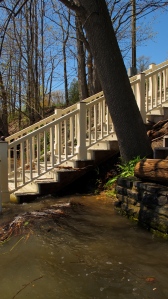
To borrow a turn of phrase from Shaye Elliott, “I’m teeter tottering between” being fully present in Essex and departing for Santa Fe, betwixt summer’s curtain call and autumn’s debut, between and betwixt scores of less-than-precisely delineated transitions.
Should I stay or should I go now? — The Clash
Fair warning: I’m mixing metaphors today. Like fusion cooking and creative cocktail concocting, I’m hoping that purists will forgive my transgression(s) and sample the experiment with an open mind.
I’ve already shared a couple of quick riffs on the push-and-pull of seasonality, wrapping up the re-decking project, re-starting the boathouse gangway project, launching the exciting new icehouse project, and recovering from August 30 storm damage. I need to flesh out all of those transitions in fuller detail soon, but today instead I’ll touch on our autumn changeover from the Adirondack Coast to the high desert southwest with an unanticipated delay for COVID and a perhaps peculiarly drawn out rumination on teeter-tottering. Fair warning!

Teasing Out Teeter-Tottering Metaphor
I’m struck, I might add, by the strength of this teeter-tottering metaphor. The teeter-totter, a seesaw, with someone sitting on the other end, riding the teeter-totter seat down to the ground, close enough to toe-touch. When fortunate, bringing the soles of both feet to rest on the ground and bending knees to squat and push off, sending teeter-totter up into the air as a friend on the other end returns to the earth.
I recollect that there’s another challenge (and distinct pleasure) to teeter-tottering as well. Sure, it’s exciting to tip one another up and down, but balancing is also appealing, both friends suspended in mid air, neither touching the ground, neither rising, neither falling. Equilibrium. Balance. A quivering stasis that requires focus and collaboration between both friends.
Obviously the principal thrill of balancing on a teeter totter is that it’s incredibly difficult. And just as obvious is the indisputable fact that teeter-totter equilibrium is it best temporary. Eventually one or the other person will come back down to the earth, planting their feet on the ground, while the other will lift skyward. It’s impossible to postpone indefinitely.
So if it’s obvious, why am I explaining it this way? I think that the allure of the teeter-tottering metaphor — at least for me, right now — is that it so perfectly conjoins otherwise dissimilar sentiments.
I’m thrilled, exhilarated, and yet anxious about the abundance of thresholds upon which we are currently balancing. Certainly there’s a very real exuberance in the moments where we shed some gravity and float high. There are butterflies in the belly (and whirlwinds of worry in the belfry) when lofty ambitions come plunging down. But like that teeter-tottering youth of my memory, I often find that we’re endeavoring to maintain some fragile equilibrium, knowing full well that we can’t maintain it forever, and yet hoping to stabilize the teeter-totter for a moment, just another moment,… Or maybe a day? A week? This is not to say that we’re in denial about the inevitability of some pretty major transitions, but it speaks honestly about our hesitance in at least some cases.
You’ve possibly noticed a parade of posts recently addressing the transitions and transformations that we’re navigating. I apologize for too often talking obliquely, speaking around the issue rather than addressing it directly. Sometimes that’s part of the process, I’m afraid. Sometimes the prologue serves the needs of the storyteller even more than the reader.
In short, please bear with me. I recognize that not everybody enjoys teeter-tottering, so thank you for your patience, and in many cases, thank you for your generosity and advice and coaching.
Know then that this curiously kaleidoscopic time and space we’re teeter-tottering through (I warned you about mixing my metaphors!) will yield to more candid sharing when the time is right, with updates aplenty including:
- The exceedingly handsome garapa deck rebuild that was completed a few weeks ago.
- The boathouse gangway rebuild v2.0 which we’ll be relaunching soon (or at least as soon as the new team can demo the dangerously misguided fiasco left behind when TFG finally admitted defeat and quit.)
- The long anticipated icehouse rehabilitation and repurposing project that will get underway by the end of the month.
With those considerably more interesting transformations in the offing soon, I’ll conclude this post with a slightly more personal teeter-tottering anecdote.
Susan and I had prepared to depart Essex for Santa Fe considerably earlier this year than we habitually do. We’d invited some friends together for a last hurrah, and Susan had prepared impeccably as she does to enjoy a comfortable journey cross-country with our dog. And, given that our friend, Hroth Ottosen, would be mirroring our north-by-southwest migration as he returns from Santa Fe to Essex to take up residence at Rosslyn while we’re away (more on this including an introduction soon) our early departure was intended to allow comfortable breathing room between our departure and his arrival. But, as they say, the best laid plans…
After exercising caution and safely eluding Covid for 2-1/2 years, Susan fell ill about a week prior to our departure. And within just under a week I followed suit. Although my recovery was fortunately quick, hers was not. In fact we were both startled with how much more pronounced her symptoms and how much longer the duration of her illness. If Covid affectively debilitated me for two days, it knocked her out for more than two weeks.
Needless to say, our pre-departure fête and our travel plans were scuttled. Throw in Labor Day travel challenges, and we ended up postponing our departure even further. Perhaps this was the universe’s way of reminding us not to become overconfident in our planning, not to assume that we can orchestrate our way out of unpredictability, setbacks, and topsy-turvy crisis management that these times of transition typically engender. All this to say, the teeter totter tumbled!
 Rosslyn Boathouse (Source: Geo Davis)[/caption]
Rosslyn Boathouse (Source: Geo Davis)[/caption]















